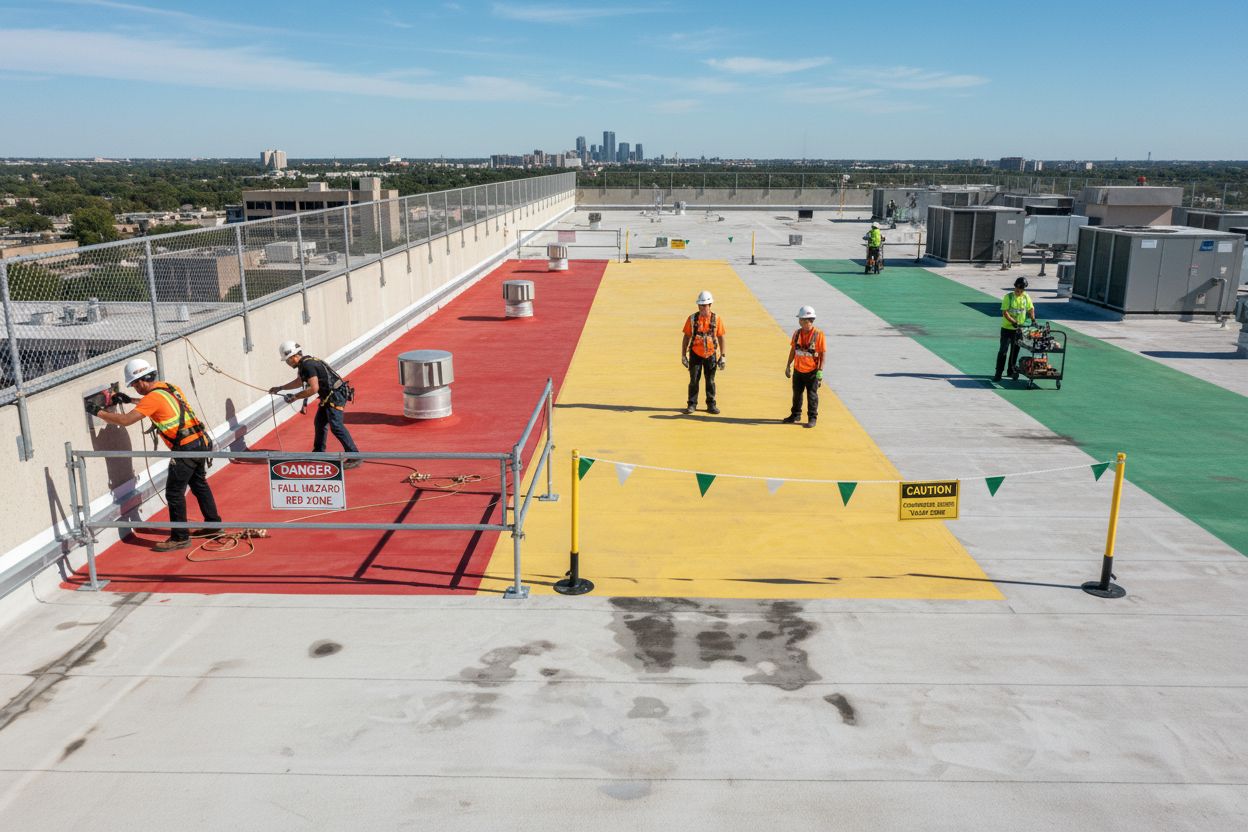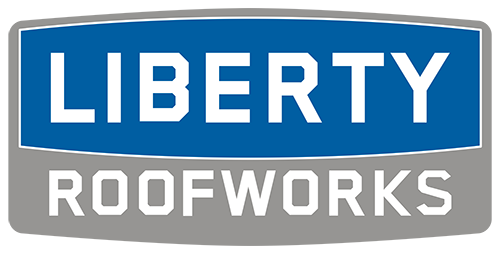Falls are the leading cause of death in construction, with one in five worker fatalities linked to roofing accidents. Every day on a jobsite presents threats that can be expensive, damaging, or even fatal if not properly managed. Understanding specific safety requirements, using the right protective gear, and following established standards makes a measurable difference in preventing injuries while keeping workers and property secure.
Key Takeaways
| Point | Details |
|---|---|
| Comprehensive Fall Protection | OSHA mandates fall protection for roofing work six feet or more above lower levels through guardrails, safety nets, or personal fall arrest systems. |
| Safety Zones Classification | Roofing hazards are categorized into safety zones which determine the required fall protection measures based on proximity to the roof edge. |
| Stringent Reporting Requirements | Starting January 1, 2024, employers must report detailed injury documentation and serious incidents to OSHA within specific timeframes. |
| Legal Responsibilities of Contractors | Roofing employers must ensure compliance with safety regulations, conduct hazard assessments, and may face severe penalties for non-compliance. |
Table of Contents
- Defining Roofing Safety Requirements And Standards
- Types Of Roofing Hazards And Risks
- Core OSHA Roofing Safety Regulations
- Essential Safety Equipment And Practices
- Legal Liabilities And Contractor Obligations
Defining Roofing Safety Requirements and Standards
Roofing safety isn’t just about having the right equipment – it’s about understanding and implementing comprehensive protection protocols that safeguard both workers and property. Learn more about roofing systems and how they play a crucial role in maintaining overall safety standards.
According to the Occupational Safety and Health Administration (OSHA), workers performing tasks on roofs six feet or more above lower levels must be protected by specific fall protection systems. These systems include conventional fall protection methods such as:
- Guardrails
- Safety nets
- Personal fall arrest systems
If implementing these standard protective measures proves infeasible, OSHA requires contractors to develop a written site-specific fall protection plan. This plan must detail precise strategies for preventing potential accidents and mitigating workplace risks.
OSHA’s interim fall protection compliance guidelines mandate several critical safety requirements. These include ensuring safe working conditions through:
- Providing stable and secure footing
- Installing slide guards
- Establishing proper staging areas
- Restricting access during high-risk activities like roof sheathing
By adhering to these comprehensive safety standards, roofing professionals can significantly reduce the risk of workplace accidents and create a safer environment for everyone involved.
Types of Roofing Hazards and Risks
Roofing is inherently dangerous, with professionals facing numerous risks that can lead to serious injuries or even fatalities. Learn more about common roof damage causes to better understand the potential hazards workers encounter daily.
According to OSHA and NIOSH research, roofing, siding, and sheet metal work rank among the highest injury-prone industries. Fall-related accidents are the primary concern, with workers experiencing severe injuries from falls as low as 16 feet. These incidents can result in significant trauma, including:
- Fractures
- Sprains
- Concussions
- Potential life-altering disabilities
OSHA has developed specific safety zone classifications for low-slope roofs to help mitigate these risks. The danger zones are categorized based on proximity to the roof’s edge:
- Extremely High Danger: Less than 6 feet from the edge
- Very High Danger: 6-15 feet from the edge
- High Danger: 15 feet or more from the edge
Each zone requires specific fall protection measures, such as guardrails, warning lines, or personal fall arrest systems. By understanding and implementing these precise safety protocols, roofing professionals can significantly reduce their risk of workplace accidents and protect themselves from potentially life-threatening situations.

Here’s a summary of key OSHA-required fall protection measures for each roof safety zone:
![]()
| Roof Safety Zone | Distance From Edge | Required Fall Protection |
|---|---|---|
| Extremely High Danger | Less than 6 feet | Guardrails Personal fall arrest Safety nets |
| Very High Danger | 6-15 feet | Warning lines Guardrails Safety monitors |
| High Danger | 15 feet or more | Restricted access Warning lines (if applicable) |
Core OSHA Roofing Safety Regulations
OSHA continues to evolve its safety regulations to protect workers in high-risk industries like roofing. Check out our roof installation guide to understand how these regulations impact professional roofing practices.
Starting January 1, 2024, OSHA has implemented stringent reporting requirements for high-hazard employers in the roofing sector. These new regulations mandate that companies submit detailed injury and illness documentation through Form 300 and Form 301 on an annual basis. Most critically, employers must report serious workplace incidents—including fatalities, amputations, and hospitalizations—within extremely tight timeframes.
A landmark regulation taking effect on January 13, 2025, focuses on personal protective equipment (PPE) standards. This new rule requires employers to provide construction workers with properly fitting protective gear. The key objectives of this regulation include:
- Ensuring PPE effectiveness
- Encouraging consistent PPE usage
- Reducing workplace injury risks
- Standardizing protective equipment requirements
These evolving regulations demonstrate OSHA’s commitment to creating safer work environments.
By continuously updating safety standards, the organization aims to minimize workplace accidents, protect worker health, and establish clear guidelines for employers in high-risk industries like roofing.
Essential Safety Equipment and Practices
Roofing safety goes far beyond basic precautions – it requires a comprehensive approach to protecting workers from potential hazards. Learn about roof repair best practices to understand the critical importance of proper equipment and techniques.
According to OSHA guidelines, personal protective equipment (PPE) is mandatory for roofing professionals. The essential protective gear includes:
- Hard hats for head protection
- Safety glasses for eye protection
- Hearing protection in noisy environments
- Cut-resistant gloves
- Non-slip footwear
- Respiratory protection when exposed to dust or chemicals
Fall protection systems are crucial for workers at heights. Fall prevention becomes mandatory when working six feet or more above lower levels, with OSHA recommending multiple protective strategies:
- Guardrail systems
- Safety nets
- Personal fall arrest systems
- Retractable lifelines
- Secure roof anchors
OSHA guidance specifically highlights the importance of specialized equipment for different roofing stages. Bracket scaffolds, safety nets, and anchored lifelines are essential when installing roof trusses, applying sheathing, or performing weatherproofing tasks. By implementing these comprehensive safety measures, roofing professionals can significantly reduce workplace accidents and protect themselves from potential injuries.
Legal Liabilities and Contractor Obligations
Roofing contractors face significant legal responsibilities that extend far beyond completing a job successfully. Explore our comprehensive roof installation guide to understand the critical legal considerations in roofing projects.
Under the Occupational Safety and Health Act, roofing employers bear comprehensive legal responsibilities for workplace safety. This means contractors are not just responsible for completing work, but for ensuring every aspect of the job meets stringent safety standards. The primary legal obligations include:
- Conducting thorough hazard assessments
- Providing comprehensive worker safety training
- Implementing approved fall protection measures
- Maintaining accurate workplace injury documentation
- Ensuring proper use of personal protective equipment
The legal implications of non-compliance are severe. Contractors can be held financially and legally accountable for:
- Workplace injury compensation
- Substantial OSHA fines
- Potential criminal negligence charges
- Loss of business licensing
- Increased insurance premiums
OSHA’s guidance emphasizes that employers must proactively assess workplace risks and implement either conventional or alternative fall protection strategies. This means developing a comprehensive safety framework that anticipates potential hazards and provides robust mitigation strategies. By prioritizing worker safety, contractors not only protect their employees but also shield themselves from potential legal and financial repercussions.
Choose Roof Safety and Reliability with Liberty Roofworks
Every year, new OSHA regulations and industry standards create more complexity for roof safety—including requirements for fall protection systems, PPE, and comprehensive documentation. If you are worried about hidden risks, costly accidents, or the legal consequences of missed details, you are not alone. This article highlights the tough challenges facing both homeowners and contractors when it comes to protecting teams and properties.
At Liberty Roofworks, your safety and peace of mind come first. Our expert team follows every industry standard and uses the latest protective equipment for all residential and commercial projects. Whether you are planning a new roof installation, or need urgent storm damage repair, we cover every step with full compliance so you avoid safety risks and legal headaches. Ready to eliminate the uncertainty and choose a roofing partner who does it right the first time? Visit Liberty Roofworks now to schedule your no-obligation assessment. Take control of your safety and get quality results today.
Frequently Asked Questions
What are the key OSHA fall protection requirements for roofing in 2025?
OSHA requires that workers on roofs six feet or more above a lower level be protected by fall protection systems, including guardrails, safety nets, or personal fall arrest systems. If these measures are not feasible, a written site-specific fall protection plan must be implemented.
What should be included in a written fall protection plan for roofing contractors?
A written fall protection plan must detail strategies for preventing accidents and mitigating workplace risks. This includes hazard assessments, training protocols, and the specific protective measures that will be used on-site.
What types of personal protective equipment (PPE) are required for roofing workers in 2025?
Roofing professionals are required to wear essential PPE such as hard hats, safety glasses, cut-resistant gloves, non-slip footwear, and respiratory protection, especially when exposed to dust and chemicals.
How often do roofing contractors need to report injuries and illnesses under the new OSHA regulations?
Starting January 1, 2024, roofing employers must report serious workplace incidents, including fatalities, amputations, and hospitalizations, to OSHA within tight timeframes, in addition to annual submissions of injury and illness documentation using Forms 300 and 301.
